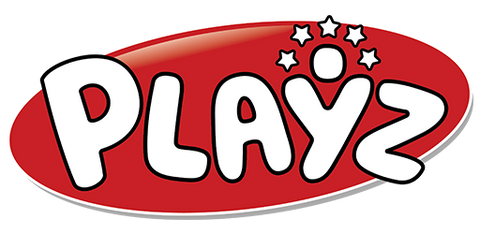
How to Organize a Toy Room: A Parent's Guide to Taming the Chaos
Knowing how to organize a toy room isn't about buying more bins—it's about creating a system that works for your family. The secret? Involving your children from the start and setting clear, achievable goals. This collaborative approach builds a foundation for a tidy space that you can actually maintain long-term, transforming clutter into a launchpad for creativity.
Setting the Stage for a Clutter-Free Playroom
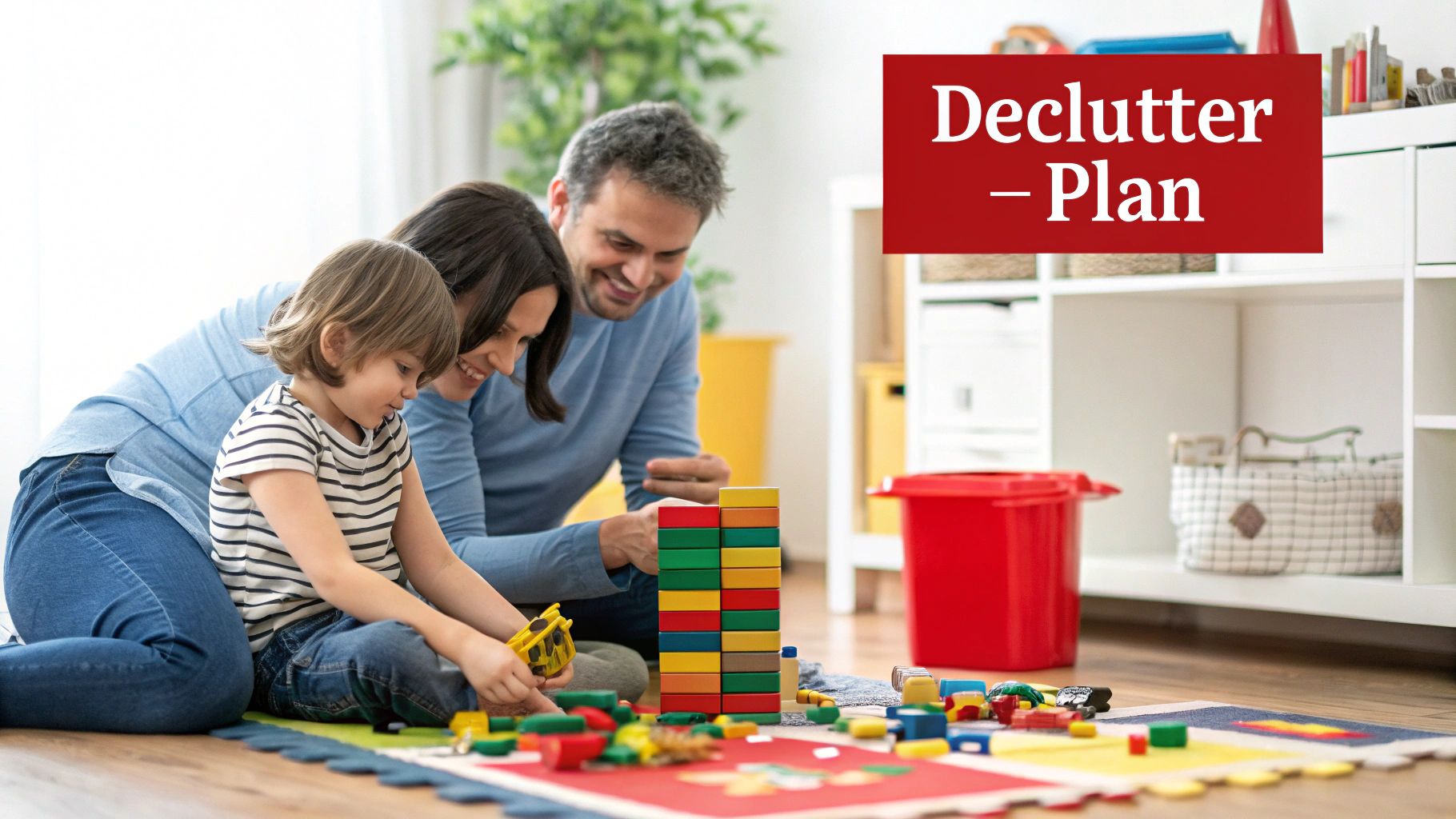
Before you sort a single toy, the most important step is a mental shift. Instead of viewing organization as a massive, one-time project, reframe it as a collaborative family activity. A tidy space reduces stress for parents, but it also helps children focus, leading to more imaginative and fulfilling play.
The key is to bring your kids into the process in a positive, age-appropriate way. This isn’t about forcing them to part with beloved toys; it's about teaching them the value of an organized space where they can easily find what they're looking for. When kids feel like they’re part of the solution, they’re far more likely to help maintain it.
Start with a Simple Assessment
First, take a moment to observe the playroom without moving anything. Where are the "clutter hotspots"? Are building blocks constantly underfoot? Are art supplies exploding from their drawer? Identifying these problem areas will help you prioritize your efforts.
Next, set a simple, realistic goal. It could be as small as "clear the main floor space" or "find a home for all the stuffed animals." Starting with small targets keeps you from feeling overwhelmed and builds momentum.
Actionable Insight: A phased approach is always better than a weekend marathon. Dedicate just 15-20 minutes a day to one small zone, like a single shelf or toy box. This makes the project manageable and prevents burnout for you and your kids.
Involve Your Kids from Day One
Explain the "why" behind the cleanup in a way they can understand. You could say, "Let's make more room for fun! When our toys have a home, it's easier to build huge castles and find your favorite puzzles."
For younger kids, turn sorting into a game. Use three boxes and label them with pictures:
- Keep: For toys they love and play with regularly.
- Donate: For toys in great shape that another child might enjoy.
- Rotate: For toys to put away for a while and swap out later.
This initial phase is also the perfect time to think about creating "zones." For example, you can designate a cozy reading corner with a soft rug and books, or an open area for larger items like the best kids' play tents. Getting this foundation right ensures your new organization system is built to last.
A Realistic Method for Decluttering Toys
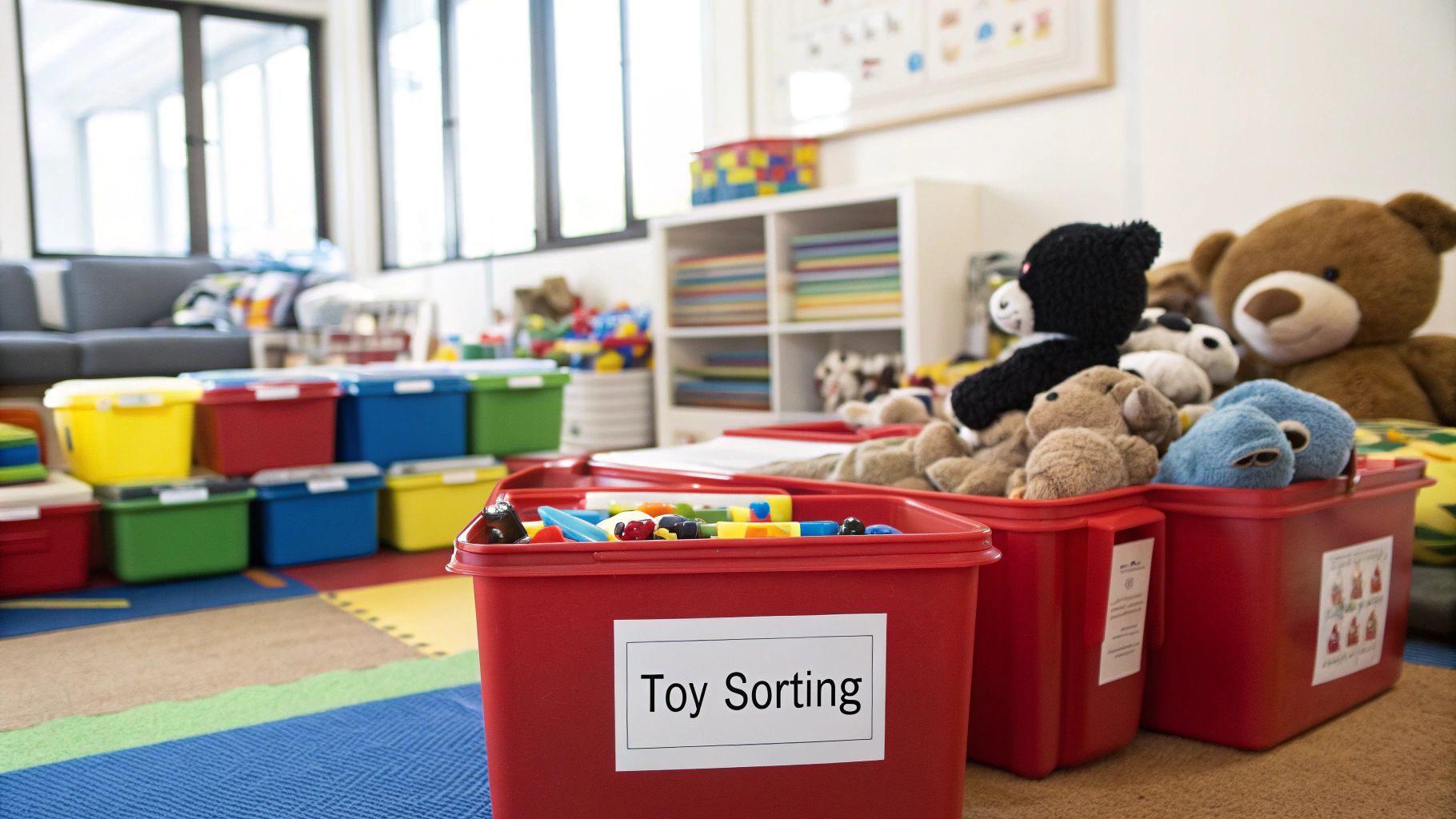
Now that you've prepped the space, it's time to tackle the mountain of toys. The goal here isn't just to make "keep" and "toss" piles. It's about a thoughtful strategy that reflects how your family plays, curating a collection that sparks joy and reduces the daily "I can't find anything!" stress.
Instead of just two piles, we'll use four distinct categories. This simple trick helps you make smarter decisions about what stays, what gets stored, and what needs to find a new home.
A Smarter Sorting System
Grab four boxes or laundry baskets and label them. This framework gives every toy a clear purpose, which is the secret to a toy room that stays organized.
- Daily Favorites: These are the non-negotiables—the toys your kids reach for almost every day. Think LEGOs, magnetic tiles, beloved dolls, or a trusty set of wooden blocks.
- Rotation Ready: Consider these the "B-team" toys. They're still great, just not in the current starting lineup. This bin is perfect for that complex science kit, seasonal craft supplies, or puzzles they’ve already mastered.
- Memory Box: This category is reserved for sentimental treasures: your baby’s first rattle, a handmade gift from a grandparent—items not for active play but too precious to let go.
- Time to Go: This is for anything broken beyond repair, missing critical pieces, or simply outgrown. Be honest with yourself about what’s no longer serving a purpose.
A flexible system is more important than ever. The U.S. toy industry has seen a 6% jump in dollar sales recently, according to The Toy Association, meaning we're all managing larger, more complex collections that a simple keep/toss method can't handle.
Actionable Insight: Be decisive but gentle, especially with sentimental items. Try to limit the "Memory Box" to one container per child. This forces you to save only what is truly meaningful and prevents sentimental clutter from taking over.
Handling the Tricky Items
As you sort, you'll encounter roadblocks. What about those endless piles of tiny pieces, like doll shoes or miniature play food? Group them into small, labeled containers right away.
Another great strategy is to sort items by age appropriateness. This makes it easy to spot what can be passed down to a younger sibling or donated. If you need a refresher, explore our guide on how to shop for toys by age to see what aligns with your child's current developmental stage. Thoughtful curation now makes playtime more focused and cleanup significantly simpler.
Choosing Storage Solutions That Kids Can Actually Use
Once you’ve sorted through the toys, the next step is giving everything a permanent home. The secret to a system that sticks is choosing storage from a kid's point of view: low, open, and easy to use. The goal is to empower them to grab what they want and—more importantly—put it away without your help.
Accessibility is your best friend. Think low-to-the-ground shelves, open-front bins, and shallow drawers they can manage themselves. If a child has to wrestle with a heavy lid or can’t reach the shelf, those toys will end up on the floor. Every time. Keeping storage at their eye level fosters independence and makes cleanup a natural part of play.
Finding the Right Storage for Your Space
The global toy storage market was valued at around $10.26 billion, according to market research, and is expected to grow, showing how many families are seeking functional, clutter-free solutions.
The trick is to match the storage type to the toy. Here’s a breakdown of popular options that work well in real-world homes:
- Open Bins and Baskets: My go-to for bulky items like stuffed animals, balls, and chunky building blocks. The "dump and go" cleanup method is a lifesaver for toddlers.
- Cube Shelves: Unbeatable for their versatility. Use fabric bins for smaller categories like toy cars or dolls, and leave some cubes open to display board games and larger playsets.
- Mobile Carts: An amazing choice for art supplies or small LEGO projects. Kids can wheel the cart to their play area and roll it back, keeping all those tiny pieces contained.
This chart gives a great visual of how easy these common storage solutions are for a child to use.
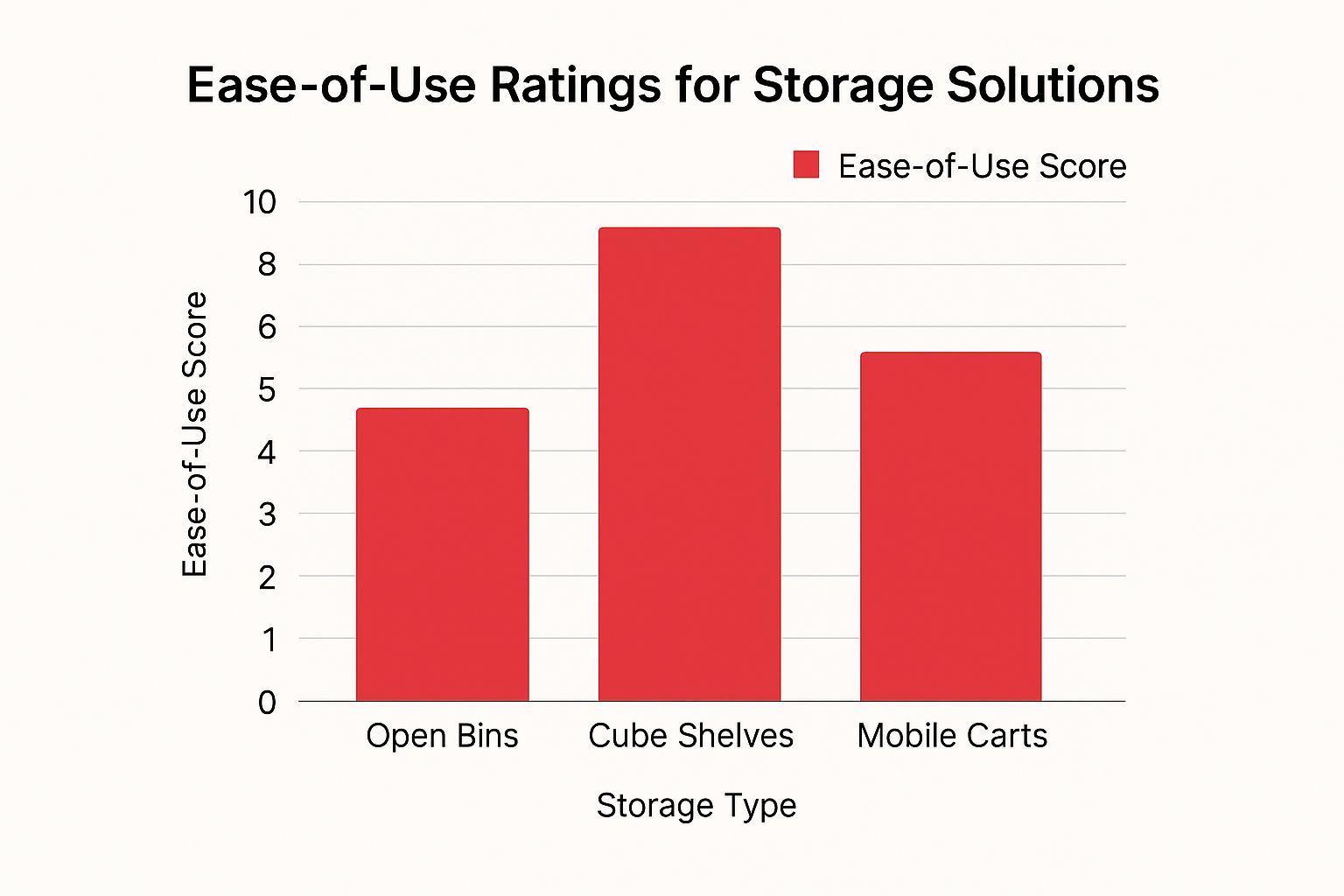
As you can see, open bins are the clear winner for ease of use, making them a fantastic starting point, especially for younger kids.
To help you decide, here's a quick comparison of popular storage options.
Toy Storage Solutions: Pros & Cons
This comparison will help you choose the best fit for different types of toys and age groups in your home.
| Storage Type | Best For | Pros | Cons |
|---|---|---|---|
| Open Bins | Stuffed animals, balls, blocks, dress-up clothes | Easiest for kids to use; "dump and go" cleanup | Can look cluttered; small items get lost at the bottom |
| Cube Shelves | Board games, books, categorized small toys (in bins) | Versatile and modular; keeps items visually separate | Fabric bins can wear out; can be a climbing hazard if not anchored |
| Mobile Carts | Art supplies, LEGOs, craft materials | Portable; keeps small project pieces together | Limited capacity; can roll away or be unstable for toddlers |
| Toy Chests | Bulky toys, blankets, outdoor gear | Hides clutter; can double as a bench | Heavy lids can be a safety hazard; becomes a "toy pit" |
Ultimately, a mix-and-match approach often works best, using different solutions for different needs within the same room.
Make Cleanup Intuitive with Labels
Labels are the final touch that turns a bunch of bins into a functional system. For little ones who can't read, picture labels are a game-changer. Simply snap a photo of the toys that belong in a bin (e.g., a picture of LEGOs), print it out, and tape it to the front. This visual cue helps them match toys to their homes without asking for help.
For larger items that don’t fit neatly into a bin, think outside the box. A pop-up play tent can become the designated "home" for all the stuffed animals, or it can be folded into its carrying case for quick storage. A versatile option like the Playz 5-piece kids playhouse jungle gym can create a dedicated play zone that's also incredibly easy to pack up. This reinforces the core idea: every single toy has its own special place.
Designing a Playful and Functional Room Layout
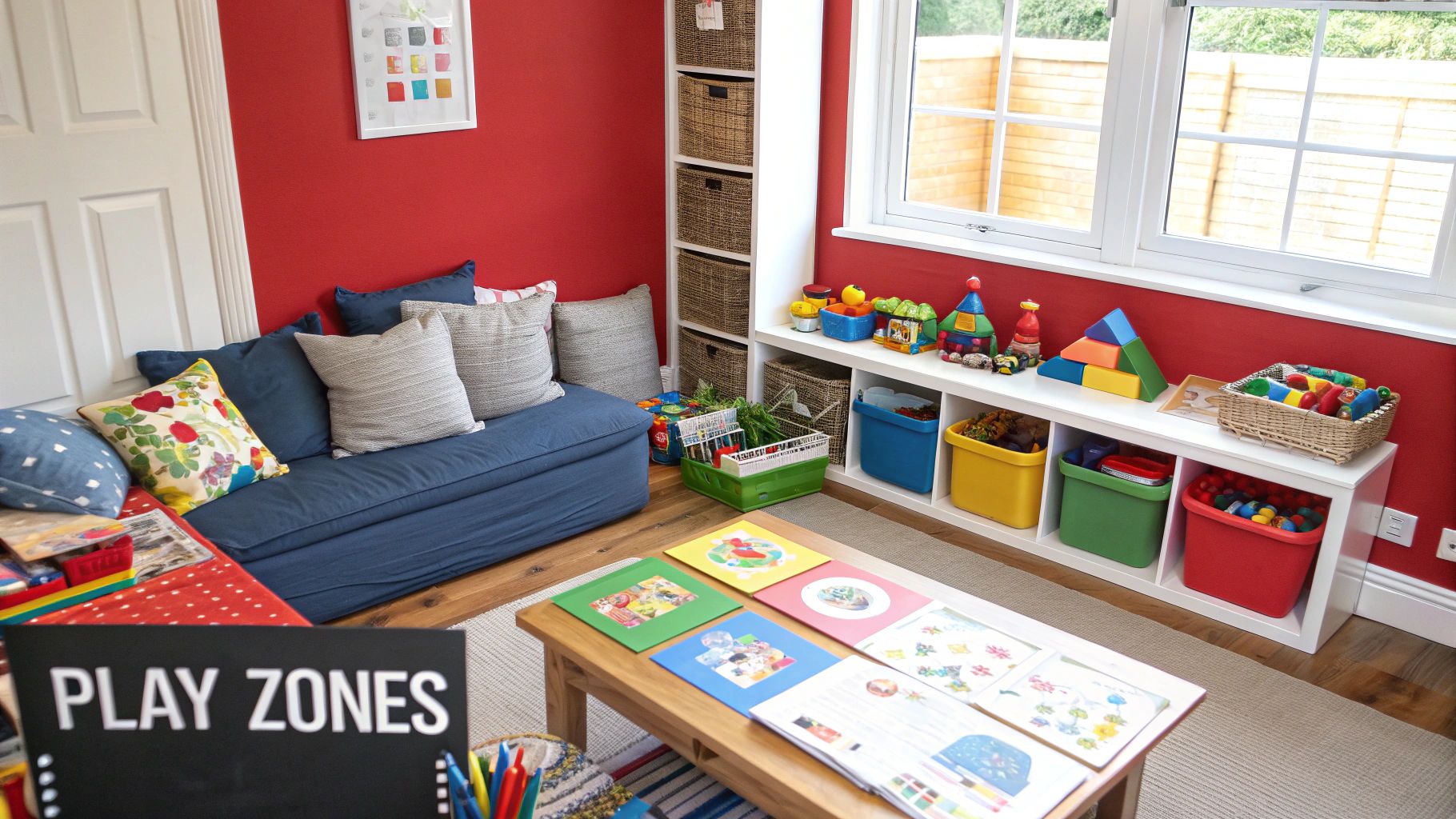
An organized toy room is much more than tidy shelves; it’s about creating a space that invites kids to play, explore, and even clean up after themselves.
The secret? Think like a city planner and create distinct "zones" for different types of play. This simple strategy naturally contains the chaos and helps kids focus on one activity at a time instead of dumping every toy onto the floor. For example, a cozy corner with a beanbag and a low bookshelf becomes the reading nook. An open patch of rug is perfect for building block towers, while a small table and chairs can be the official art station. This approach doesn't just look tidier; it also supports the principles of play-based learning, giving kids a structured environment to dive into what they love.
Create a 'Toy Library' with a Rotation System
One of the most powerful strategies for maintaining an organized playroom is the toy rotation. It sounds complicated, but it's simple: you need a closet or a few large bins stored out of sight. Think of this as your family's personal "toy library."
Here’s how it works:
- Keep a manageable number of toys out. About one-third of the total collection is often the sweet spot.
- Store the rest away in clearly labeled bins. This is your "library."
- Swap toys out every few weeks or whenever you notice kids getting bored with what's available.
Key Takeaway: This method keeps the playroom feeling fresh and exciting without you buying anything new. "Old" toys feel special again, which encourages deeper engagement and makes the daily tidy-up much faster for everyone.
The demand for smart storage is booming. The kids' storage furniture market, currently valued at USD 14.65 billion, is expected to keep growing as parents seek solutions that are both functional and stylish. By setting up a thoughtful layout and a simple rotation system, you're not just organizing toys; you're building an environment for joyful, focused play.
Building Habits to Maintain Your Organized Space
You’ve done the hard part: the toys are sorted, the bins are labeled, and the room looks amazing. The real victory, however, is keeping it that way. This is all about creating simple, sustainable routines that prevent clutter from creeping back in.
The goal is to weave cleanup into your family’s daily rhythm, not treat it as a dreaded chore.
One of the most effective routines is the 10-Minute Tidy-Up. Every evening before bed, set a timer for ten minutes and have everyone—yes, even grown-ups—pitch in to put things back where they belong. Making it a predictable, daily habit reduces resistance and keeps the mess from ever getting out of hand.
Empowering Kids to Help
For kids to truly participate, the system must be dead simple. This is where visual labels are a game-changer, especially for pre-readers. A picture of LEGOs on the LEGO bin empowers them to match items to their correct homes without constantly asking for help.
Remember, consistent and positive reinforcement is your best tool.
Actionable Insight: Celebrate effort, not perfection. A simple, “Great job putting your cars away!” builds confidence and reinforces the habit far more effectively than criticism ever could. The goal is participation, not a perfectly curated shelf.
Conducting Regular Resets
Finally, get ahead of the inevitable clutter influx by planning quick resets before birthdays and holidays. You know new toys are coming, so this is the perfect time to declutter and make space. It's a proactive move that saves you a massive headache later.
Teaching children organizational habits has benefits beyond a tidy room. By building these routines, you're setting the foundation for other healthy boundaries. It's a great jumping-off point for exploring other challenges, like finding balance with our guide on how to limit screen time.
Frequently Asked Questions (FAQ)
Even with the perfect plan, you're bound to hit a few snags. Here are answers to some of the most common challenges parents face when organizing a toy room.
What do I do about decluttering meltdowns?
The dreaded decluttering meltdown is avoidable. The key is to frame the task in a fun, positive way and keep it short. Instead of saying, "We need to get rid of your old toys," try, "Let's make space for new adventures!" This shifts the focus from loss to possibility. Keep choices simple to avoid overwhelming them. Asking, "Which two cars should we keep in the play box?" works better than the open-ended, "What do you want to get rid of?"
A few other tricks that work wonders:
- Set a timer. Keep sorting sessions to just 15-minute bursts.
- Turn it into a game. "Who can find all the red toys the fastest?"
- Pick your moment. Never attempt to declutter when a child is tired or hungry.
Most importantly, celebrate their helpfulness afterward. A little positive reinforcement goes a long way.
What's the best way to organize LEGOs?
For toys with a million tiny pieces like LEGOs, the name of the game is containment and visibility. You want them contained so they aren't all over the floor, but visible so kids can find that one specific piece they need right now.
Large, flat under-bed storage containers are fantastic for this. Kids can spread the pieces out inside the bin to see everything without making a mess on the carpet. Another great option is a play mat that cinches up into a storage bag. For other small collections like doll shoes or craft supplies, clear, stackable containers with dividers are ideal. Picture labels are absolutely essential for pre-readers, empowering them to put things away correctly on their own.
How often should I rotate toys?
Toy rotation is one of the best-kept secrets of a peaceful playroom. A good rhythm to aim for is every two to four weeks, but the best indicator is your child's interest.
Actionable Insight: A good rule of thumb is to keep about half of their toys stored away at any given time.
When you notice they're losing interest in what’s out, it's time for a swap. Pull out a new bin from the "toy library" and put the old ones away. This simple trick keeps the playroom feeling fresh, dramatically cuts down on the number of toys out at once, and makes daily cleanup much faster.
At Playz, we believe in creating environments that spark curiosity and make learning fun. An organized space is the perfect canvas for your child's imagination. Explore our collection of engaging toys designed to inspire their next big adventure. Visit us today at https://www.playzusa.com to find the perfect addition to your newly organized playroom.
